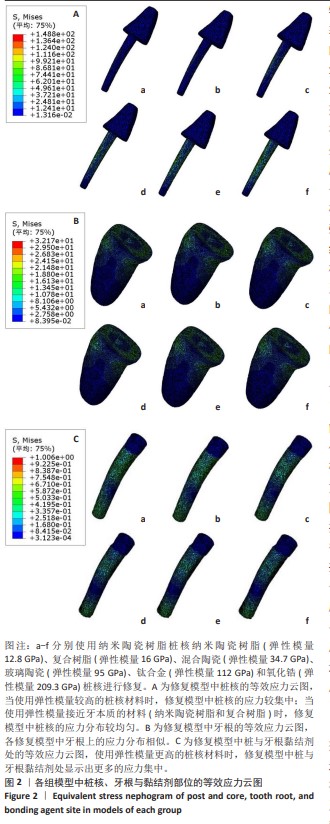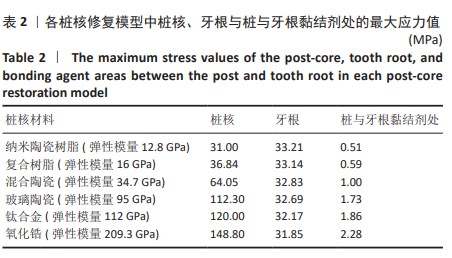[1] KOLE S, ERGUN G. Bond strength of various post-core restorations with different lengths and diameters following cycle loading. J Mech Behav Biomed Mater. 2023;142:105804
[2] WU Y, QI H, WANG D, et al. Evaluation of custom posts and cores fabricated by two digital technologies in core and post space dimensions. J Prosthodont. 2023. doi: 10.1111/jopr.13742
[3] GUO X, CHEN Z, GAO M, et al. Synchronous Fabrication of Custom One-piece Glass Fiber Post-and-core and Zirconia Crown by a Fully Digital Workflow. Oper Dent. 2023;48(2):130-136.
[4] MEZIED MS, ALHAZMI AK, ALHAMAD GM, et al. Endocrowns Versus Post-core Retained Crowns as a Restoration of Root Canal Treated Molars - A Review Article. J Pharm Bioallied Sci. 2022;14(1):39-42.
[5] QAMAR Z, ALGHAMDI A, HAYDARAH N, et al. In Vitro Evaluation of Lithium Disilicate Endocrowns and Post and Core Crowns-A Systematic Review. J Funct Biomater. 2023;14(5):276-283.
[6] ZHAO T, JIANG Z, GE Y, et al. Mechanical properties, biosafety, and shearing bonding strength of glass fiber-reinforced PEEK composites used as post-core materials. J Mech Behav Biomed Mater. 2023;145: 106047.
[7] VOGLER JAH, BILLEN L, WALTHER KA, et al. Conventional cast vs. CAD/CAM post and core in a fully digital chairside workflow – An in vivo comparative study of accuracy of fit and feasibility of impression taking. J Dent. 2023;136:104638.
[8] BASTOS NA, SANTOS DM, BATISTA VES, et al. Can ferrule effect reduce failures in fiber post-retained restorations? Meta-analysis. Dent Mater. 2018;34:10-17.
[9] MAALHAGH-FARD A, PACHECO RR, GILL K, et al. Effects of Ferrule and Diameter of Parallel Cast Post and Core on Fracture Resistance. Br Dent Sci. 2019;22(4):538-545.
[10] KHABADZE Z, MORDANOV O, TARAKI F, et al. Effects of the ferrule design on fracture resistance to endodontically-treated teeth restored with fiber posts: a systematic review. Open Dent J. 2019;13(1):493-498.
[11] GLORIA A, MAIETTA S, MARTORELLI M, et al. FE analysis of conceptual hybrid composite endodontic post designs in anterior teeth. Dent Mater. 2018;34(7):1063-1071.
[12] RODRIGUES MP, SOARES PBF, VALDIVIA ADCM, et al. Patient-specific Finite Element Analysis of Fiber Post and Ferrule Design. J Endod. 2017;43(9):1539-1544.
[13] AUSIELLO P, GLORIA A, MAIETTA S, et al. Stress distributions for hybrid composite endodontic post designs with and without a ferrule: FEA study. Polymers (Basel). 2020;12(8):1836.
[14] FRÁTER M, LASSILA L, BRAUNITZER G, et al. Fracture resistance and marginal gap formation of post-core restorations: influence of different fiber-reinforced composites. Clin Oral Investig. 2020;24(1):265-276.
[15] VENKATARAMAN KJ, THANAPATHI S, BALASUBRAMANIAN S, et al. Fracture resistance of titanium, chrome–cobalt, and gold alloy as post and core materials: A comparative evaluation. J Pharm Bioallied Sci. 2020;12(Suppl 1):S583-S588.
[16] ALKHATRI R, SALEH ARM, KHEDER W. Impact of post and core materials on the apical extension of root fracture in root canal treated teeth. J Mater Res Technol. 2021;10:730-737.
[17] BAKIRTZOGLOU E, KAMALAKIDIS SN, PISSIOTIS AL, et al. In vitro assessment of retention and resistance failure loads of complete coverage restorations made for anterior maxillary teeth restored with two different cast post and core designs. J Clin Exp Dent. 2019; 11(3):e225-e230.
[18] 逄键梁,冯昌芬,邓天政,等.不同桩核系统修复上颌中切牙薄弱根管的三维有限元分析[J].实用口腔医学杂志,2018,34(5): 596-600.
[19] KAINOSE K, NAKAJIMA M, FOXTON R, et al. Stress distribution in root filled teeth restored with various post and core techniques: effect of post length and crown height. Int End J. 2015;48(11):1023-1032.
[20] TSUKAHARA R, KOMADA W, OISHI S, et al. Fracture strength of flared root canals reinforced using different post and core materials. J Prosthodont. 2023;32(7):639-645.
[21] DAL PIVA AMO, TRIBST JPM, SOUZA ROAE, et al. Influence of Alveolar Bone Loss and Cement Layer Thickness on the Biomechanical Behavior of Endodontically Treated Maxillary Incisors: A 3-dimensional Finite Element Analysis. J Endod. 2017;43(5):791-795.
[22] BEUER F, SCHWEIGER J, EDELHOFF D. Digital dentistry: an overview of recent developments for CAD/CAM generated restorations. Br Dent J. 2008;204(9):505-511.
[23] LAWSON NC, BANSAL R, BURGESS JO. Wear, strength, modulus and hardness of CAD/CAM restorative materials. Dent Mater. 2016;32(11): e275-e283.
[24] TURKER SB, ALKUMRU HN, AKALIN B. Fracture resistance of endodontically treated canines restored with different sizes of fiber post and all-ceramic crowns. J Adv Prosthodont. 2016;8(2):158-166.
[25] 杨家雪,谢海峰,李林,等.插销式数字化氧化锆桩冠插销形态合理性的三维有限元分析[J].口腔生物医学,2020,11(4):252-255.
[26] 刘莹莹.上颌中切牙不同设计氧化锆桩核冠的三维有限元分析[D].南宁:广西医科大学,2010.
[27] FRANZ M, ÖZCAN M. Adhesion of bulk-fill resin composites as core and intraradicular post materials only versus the use of glass-fiber posts in different regions of root dentin. J Adhes Sci Technol. 2019;33(13): 1410-1425.
[28] 何立辉,刘立杰,高贝,等.不同粘接剂对后牙分裂桩冠修复应力分布影响的有限元分析[J].华西口腔医学杂志,2013,31(4):348-352.
[29] 李冰,张晔,武秀萍,等.有限元法分析不同粘接剂对全瓷冠应力分布的影响[J].口腔材料器械杂志,2014,23(2):89-92.
[30] DO NASCIMENTO WF, DE ANDRADE GS, TRIBST JPM, et al. One-piece, CAD/CAM, fiber-reinforced composite post and core: a case report. Gen Dent. 2021;69(6):64-68.
[31] ULUSOY N, GULEC ALAGOZ L. Evaluation of two CAD/CAM materials for Nayyar core and post-retained restorations: Three dimensional stress analysis. J Mech Behav Biomed Mater. 2021;117:104381.
[32] AWAD MA, MARGHALANI TY. Fabrication of a custom-made ceramic post and core using CAD-CAMtechnology. J Prosthet Dent. 2007; 98(2):161-162.
[33] 梅子彧,鲁雨晴,楼雨欣,等.数字光处理打印牙科氧化锆的微观结构和机械性能研究[J].华西口腔医学杂志,2021,39(5):576-581.
[34] 尤左令.基于SLM的多孔金属桩核的研究[D].杭州:浙江工业大学,2015.
[35] 李宁,王丁,白保晶,等.选择性激光烧结多孔桩的力学性能研究[J].北京口腔医学,2022,30(4):238-241.
[36] 沈凯奇.纤维桩修复不同形态上颌尖牙根管有限元分析及其3D打印技术研究[D].郑州:郑州大学, 2017.
[37] LIBONATI A, DI TARANTO V, GALLUSI G, et al. CAD/CAM customized glass fiber post and core with digital intraoral impression: a case report. Clin Cosmet Investig Dent. 2020;12:17-24.
[38] ALKHATRI R, SALEH ARM, KHEDER W. Evaluating fracture resistance and failure modes of root filled teeth restored with CAD/CAM-fabricated post and core. Clin Cosmet Investig Dent. 2019;11:349-355.
[39] LI F, SHAO Y, HAN T, et al. Finite element analysis of endodontically treated premolars without ferrule restored with one-piece glass fiber post and core in combination with different inner shoulder retention form systems. J Mech Behav Biomed Mater. 2023;143:105912.
[40] MOSHARRAF R, FATHI A, BOTSHEKAN SS. Comparative Evaluation of the Effect of Core Type and Antirotational Post on Stress Distribution in an Endodontically Treated Maxillary First Molar: FEA. Int J Dent. 2022:4336980.
[41] ADWANI S, ELSUBEIHI E, ZEBARI A, et al. Effect of Different Silane Coupling Agents on the Bond Strength between Hydrogen Peroxide-Etched Epoxy-Based- Fiber-Reinforced Post and Composite Resin Core. Dent J (Basel). 2023;11(6):142.
[42] FRÁTER M, LASSILA L, BRAUNITZER G, et al. Correction to: Fracture resistance and marginal gap formation of post-core restorations: influence of different fiber-reinforced composites. Clin Oral Investig. 2021;25(5):3339-3340.
[43] FRÁTER M, SÁRY T, BRAUNITZER G, et al. Fatigue failure of anterior teeth without ferrule restored with individualized fiber-reinforced post-core foundations. J Mech Behav Biomed Mater. 2021;118:104440.
[44] HOFSTEENGE JW, GRESNIGT M. The Influence of Dentin Wall Thickness and Adhesive Surface in Post and Core Crown and Endocrown Restorations on Central and Lateral Incisors. Oper Dent. 2021;46(1): 75-86.
[45] UCTASLI S, BOZ Y, SUNGUR S, et al. Influence of Post-Core and Crown Type on the Fracture Resistance of Incisors Submitted to Quasistatic Loading. Polymers (Basel). 2021;13(7):1130.
[46] VANDERLEI A, BOTTINO MA, VALANDRO LF. Evaluation of resin bond strength to yttria-stabilized tetragonal zirconia and framework marginal fit: comparison of different surface conditionings. Oper Dent. 2014;39(1):50-63.
[47] BORBA M, DE ARAÚJO MD, DE LIMA E, et al. Flexural strength and failure modes of layered ceramic structures. Dent Mater. 2011;27(12): 1259-1266. |

